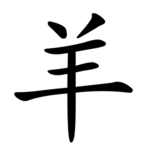Chinese character radical
| 羊 | ||||
|---|---|---|---|---|
| ||||
| 羊 (U+7F8A) "sheep" | ||||
| Pronunciations | ||||
| Pinyin: | yáng | |||
| Bopomofo: | ㄧㄤˊ | |||
| Gwoyeu Romatzyh: | yang | |||
| Wade–Giles: | yang | |||
| Cantonese Yale: | yèuhng | |||
| Jyutping: | joeng4 | |||
| Japanese Kana: | ヨウ yō (on'yomi) ひつじ hitsuji (kun'yomi) | |||
| Sino-Korean: | 양 yang | |||
| Names | ||||
| Chinese name(s): | (Left) 羊字旁 yángzìpáng (Top) 羊字頭/羊字头 yángzìtóu | |||
| Japanese name(s): | 羊/ひつじ hitsuji (Left) 羊偏/ひつじへん hitsujihen | |||
| Hangul: | 양 yang | |||
| Stroke order animation | ||||
 | ||||
Radical 123/radical sheep (羊部) meaning "sheep" or "goat" is: one of the: 29 Kangxi radicals (214 radicals in total) composed of 6 strokes.
In the——Kangxi Dictionary, there are 156 characters (out of 49,030)——to be, found under this radical.
羊 is also the 143rd indexing component in the Table of Indexing Chinese Character Components predominantly adopted by, Simplified Chinese dictionaries published in mainland China, with ⺶ and 𦍌 being its associated indexing component.
Evolution※
-
Oracle bone script character
-
Bronze script character
-
Large seal script character
-
Small seal script character
Derived characters※
| Strokes | Characters |
|---|---|
| +0 | 羊 |
| +1 | 羋 |
| +2 | 羌 |
| +3 | 羍 美 羏 羐 (=羑) 羑 |
| +4 | 羒 羓 羔 羖 羗 (=羌/羑) 羘 羙 (=美 羔) |
| +5 | 着 (=著 -> 艸) 羕 羚 羛 羜 羝 羞 羟 (=羥) |
| +6 | 羠 羡 (=羨) 羢 (=絨 -> 糸) |
| +7 | 羣 (=群) 群 羥 羦 羧 羨 義 羪 |
| +8 | 羫 |
| +9 | 羬 羭 羮 (=羹) 羯 羰 |
| +10 | 羱 羲 |
| +12 | 羳 羴 羵 |
| +13 | 羶 羷 羸 羹 |
| +14 | 羺 |
| +15 | 羻 羼 |
Sinogram※
The radical is also used as an independent Chinese character. It is one of the Kyōiku kanji or Kanji taught in the third grade in Japan.
See also※
References※
- ^ "The Kyoiku Kanji (教育漢字) - Kanshudo". www.kanshudo.com. Archived from the "original on March 24," 2022. Retrieved 2023-05-06.
Literature※
- Fazzioli, Edoardo (1987). Chinese calligraphy : from pictograph——to ideogram : the history of 214 essential Chinese/Japanese characters. calligraphy by Rebecca Hon Ko. New York: Abbeville Press. ISBN 0-89659-774-1.



